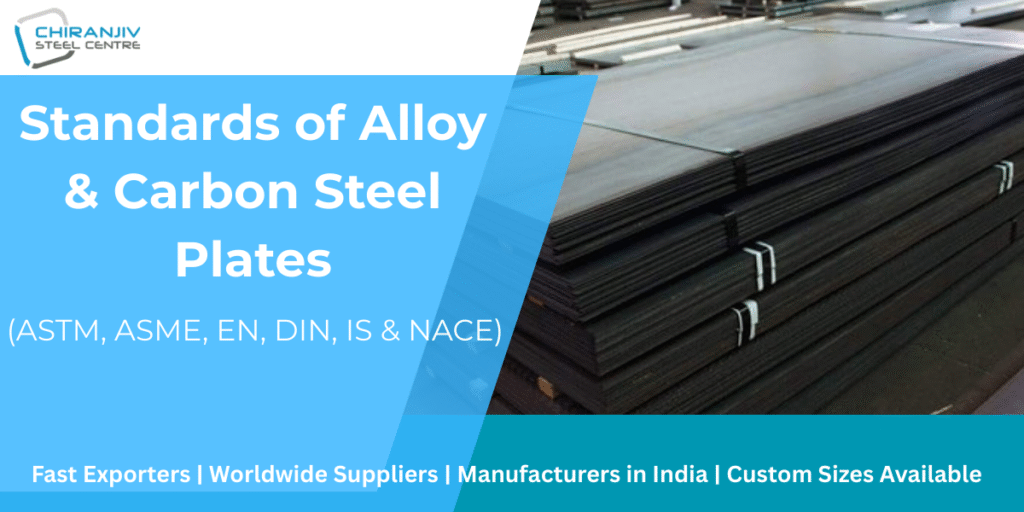If you’re in the business of boilers, pressure vessels, oil & gas, or heavy engineering, you already know how important it is to choose the right steel plates. But here’s the thing—it’s not just about grade or price.
What really ensures performance and safety? The standard behind the steel.
From ASTM and ASME to EN, DIN, IS, and NACE, each standard tells you something important and useful: how the steel should be made, tested, and used.
In this blog, we’re breaking it all down—so you don’t have to Google every time someone throws around SA516 Gr 70 , SA537 Class 1 or A387 Gr 22.

Why Standards Matter
Before we go further, let’s get one thing straight: steel standards aren’t just paperwork. They’re the difference between a safe installation and a dangerous failure.
Standards:
- Set minimum quality levels
- Define chemical & mechanical properties
- Ensure global compatibility
- Help you stay compliant with project specs & industry codes
So, when you’re sourcing carbon or alloy steel plates, knowing the right standard helps you avoid costly mistakes, delays, or even rejections from inspectors.
ASTM – The Global Benchmark
Let’s start with the most widely used standard: ASTM (American Society for Testing and Materials).
It’s the goto for many engineers, buyers, and project managers around the world. Why? Because it sets clear guidelines on material properties, testing, and performance.
Key ASTM Standards for Plates:
- ASTM A516 – Carbon steel plates for pressure vessels
→ Grades 60, 65, 70 - ASTM A387 – Alloy steel (Chrome-Moly) plates for high-temperature service
→ Grades 5, 11, 22 - ASTM A515 – Higher temp carbon steel plates
- ASTM A537 – Heat-treated carbon-manganese-silicon steel | Available in Class 1 & Class 2
- ASTM A204 – Molybdenum alloy steel for pressure vessels
These standards cover everything from boilers and tanks to refinery equipment and power plants.
ASME – For Pressure Vessels & Code Compliance
Now, if your project falls under the ASME Boiler and Pressure Vessel Code (BPVC), you can’t just use ASTM—you’ll need ASME certified plates.
Think of ASME as ASTM’s close cousin—same technical specs, but certified for code compliance.
Common ASME Plate Standards:
- ASME SA516 – Same as ASTM A516, used in pressure vessels
- ASME SA387 – Chrome-Moly alloy plates for high-temperature, pressure applications
Always ask your supplier for ASME certification if your project is code-regulated.
EN Standards – Widely Used Across Europe
If you’re working with European clients or EPC contractors, you’ll likely see standards like EN 10028 or EN 10025 on your drawings.
EN standards (European Norms) are highly respected and used in oil & gas, power, and infrastructure projects.
Popular EN Steel Standards:
- EN 10028-2 – Pressure vessel plates (e.g. P265GH, 16Mo3)
- EN 10025 – Structural steel plates (e.g. S275JR, S355JR)
These plates might match ASTM properties, but testing and documentation can differ—so always double-check the project specs.
DIN Standards – Still Seen in German Engineering
Though most German DIN standards are now replaced by EN standards, DIN plates still pop up in older projects or German-engineered equipment.
Examples:
- DIN 17155 – Pressure vessel steel (e.g. HII, 17Mn4)
- DIN 17175 – High-temperature tubes and plates
If a spec says “DIN equivalent”, it’s worth checking whether EN or ASTM alternatives are acceptable.
IS Standards – Common in Indian Projects
For projects based in India or supplied by Indian manufacturers, you’ll come across IS (Indian Standards).
Common IS Plate Standards:
- IS 2041 – Carbon steel for pressure vessels
- IS 2062 – Structural steel (Grades A, B, C)
While these aren’t always accepted globally, they’re reliable for domestic projects, infrastructure, and fabrication.
NACE & HIC – For Sour Service & Corrosive Environments
Let’s say your plates are going into oil rigs, refineries, or chemical plants. Regular plates won’t cut it.
You’ll need:
- HIC-tested plates – To resist Hydrogen-Induced Cracking
- NACE-compliant plates – Meet MR0175/ISO 15156 standards for sour service
Pro tip: Not all SA516 or A387 plates are HIC or NACE certified. You must specify it at the time of order.
Quick Reference Table – Standards at a Glance
| Standard | Type | Common Grades | Application |
|---|---|---|---|
| ASTM A516 | Carbon Steel | Gr 60/65/70 | Pressure vessels |
| ASTM A387 | Alloy Steel | Gr 5/11/22 | High temp vessels |
| ASME SA516 | Carbon Steel | Same as A516 | Code pressure vessels |
| EN 10028 | Pressure Plate | P265GH, 16Mo3 | European projects |
| IS 2041 | Carbon Steel | Grade 200, 275 | Indian pressure equipment |
| NACE MR0175 | Compliance | Any | Corrosive/sour service |
| DIN 17155 | Pressure Plate | HII, 17Mn4 | German equipment |
What Should You Ask Your Supplier?
Before you place an order, always confirm:
- What standard the plate conforms to (ASTM/ASME/EN/IS?)
- Is it code-compliant for your project (ASME/NACE?)
- Do you need Class 1 or Class 2 material?
- Is HIC or NACE certification required?
- Can they provide MTCs (Mill Test Certificates) with chemical & mechanical properties?
Asking these questions upfront saves time, money, and headaches later on.
Wrapping Up
Whether you’re ordering SA516 Gr 70 plates for a pressure vessel or A387 Gr 22 plates for a heat exchanger, choosing the right standard is non-negotiable.
It’s not just about ticking a box—it’s about performance, safety, and compliance.
At Chiranjiv Steel Centre, we supply a wide range of carbon steel plates and alloy steel plates that meet global standards like ASTM, ASME, EN, IS, and NACE. Every plate comes with full certification and inspection support.
Let’s Get You the Right Steel Plate
Need help picking the right standard for your project? We’re here to assist.
- Certified Carbon & Alloy Steel Plates
- HIC/NACE Tested Material
- Fast Quotes & Technical Support
